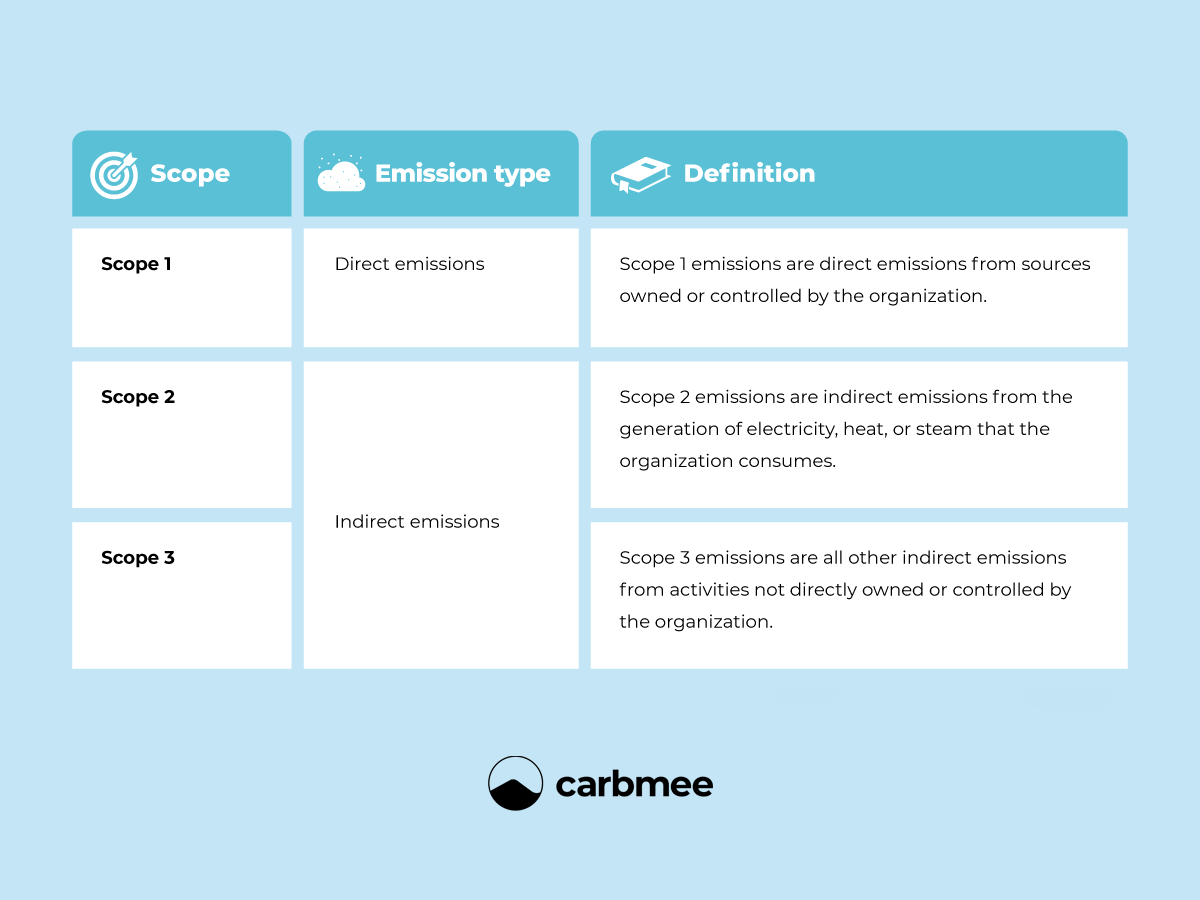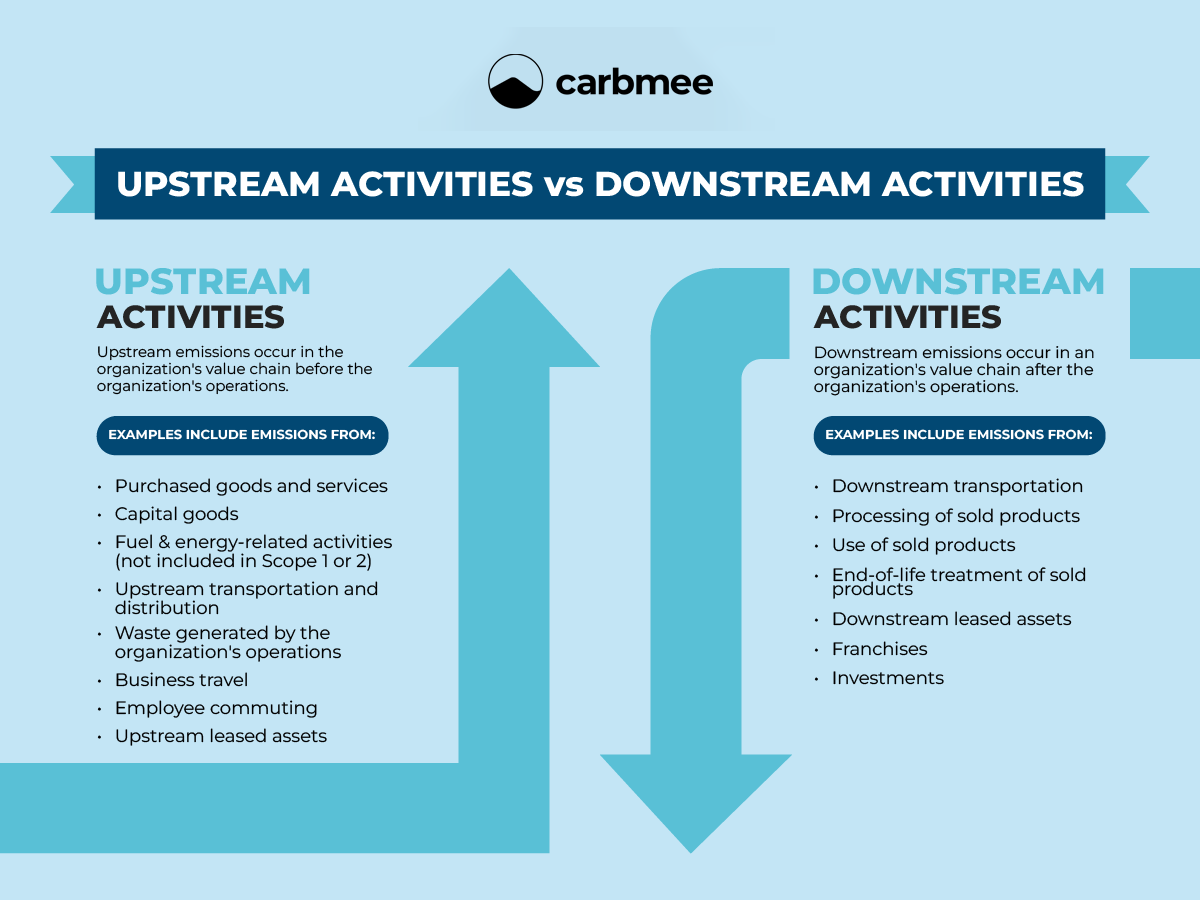What Is the Greenhouse Gas (GHG) Protocol?
The GHG Protocol is the world's most comprehensive and widely used standardized framework for measuring and managing greenhouse gas (GHG) emissions. Established in 1998 as a partnership between the World Resources Institute (WRI) and the World Business Council for Sustainable Development (WBCSD), its primary goal is to help businesses, governments, and organizations everywhere to account for, report, and ultimately reduce their emissions.
What Are Scope 1, 2, and 3 Emissions? (Definition)
The GHG Protocol categorizes emissions into three groups, or "scopes." This system helps organizations identify where their emissions are coming from and what level of control they have over reducing them.

Scope 1 Emissions: Direct Emissions From Owned Sources
Scope 1 emissions are direct GHG emissions that occur from sources owned or controlled by the company. This means they are released directly into the atmosphere as a result of the company's own day-to-day activities. Reporting for Scope 1 emissions is mandatory for most reporting frameworks.
Examples of Scope 1 emissions include:
Mobile Combustion: Emissions from company-owned or controlled vehicles (e.g., cars, vans, trucks).
Stationary Combustion: Emissions from burning fuels in stationary sources like boilers, furnaces, and generators.
Process Emissions: Emissions released during industrial processes and on-site manufacturing.
Fugitive Emissions: Leaks of greenhouse gases from equipment, such as from refrigeration or air conditioning units.
Scope 2 Emissions: Indirect Emissions From Purchased Energy
Scope 2 emissions are indirect emissions generated from the purchase of electricity, steam, heat, or cooling. Although these emissions are created at the facility where the energy is generated, they are attributed to the end-user (the company that purchases and consumes the energy). Reporting for Scope 2 emissions is also mandatory.
Scope 3 Emissions: All Other Indirect Emissions
Scope 3 emissions include all other indirect emissions that occur in a company's value chain but are not included in Scope 2. These emissions are a consequence of the company's activities but originate from sources not owned or controlled by the company. They are often the largest and most complex component of a company's carbon footprint.
While organizations must report Scope 1 and Scope 2 emissions, Scope 3 reporting is optional. However, it is highly encouraged to account for and report these emissions since they account for around 70% of the total GHG footprint.
A Deep Dive Into Scope 3 Emissions
Scope 3 emissions are divided into 15 distinct categories, which are classified as either "upstream" or "downstream" depending on where they occur in the value chain.

Upstream Scope 3 Emissions
Upstream emissions are related to purchased or acquired goods and services and occur before the product reaches the company. The eight categories are:
1. Purchased Goods and Services (Scope 3.1): Cradle-to-gate emissions from the production of goods and services a company purchases. This means that they have an impact from the moment of production until the moment the product arrives at a store or other sales space. The reporting company must also account for the extraction, production, and transportation of services or goods purchased, leased, or otherwise acquired.
2. Capital Goods (Capital Assets): Emissions from the production of capital assets purchased by the company, like machinery or buildings. They also have a cradle-to-gate impact. The upstream impact of capital goods comes from their extraction, production, and transportation upon purchase or acquisition by the reporting company.
3. Fuel and Energy-Related Activities: Emissions from the extraction, production, and transportation of fuels and energy acquired or purchased by the reporting company, not already included in Scope 1 or 2. Here is a breakdown of the different categories of this particular Scope 3 upstream activity:
- Upstream emissions of purchased fuels consumed by the reporting company.
- Upstream emissions of purchased electricity with the extraction, production, and transportation of fuels used when generating electricity, steam, and heating and cooling used by the reporting company.
- Transmission and distribution (T&D) losses result from generating electricity, steam, heating, and cooling and are reported by the end user.
- Generation of purchased electricity, steam, and heating and cooling is later sold to end users and reported by a utility company or energy retailer.
4. Upstream Transportation and Distribution: Emissions from transportation via air, road, rail, sea, and third-party transportation or related to storage. These upstream activities might include:
- Transportation and distribution of products purchased by the reporting company for its operations or between tier 1 suppliers in vehicles and facilities owned by someone other than the reporting company.
- Transportation and distribution services by the reporting company, focusing on inbound and outbound logistics and transportation and distribution between businesses' different facilities.
5. Waste Disposal and Treatment: Emissions from the disposal and treatment of waste generated by the reporting company's operations. Waste matters might include wastewater, landfill, or composting.
6. Business Travel: Emissions from the transportation of employees for business-related activities by air, bus, rail, or rental car.
7. Employee Commuting: Emissions generated during employees' commutes to and from work (by car, rail, bus, air, subway, or teleworking).
8. Upstream Leased Assets: Emissions from the operation of assets leased by the company.
Downstream Scope 3 Emissions
Downstream emissions are primarily related to the company's sold goods and services and occur after the product leaves the company's control. The categories are:
9. Downstream Transportation and Product Distribution: Emissions that occur when the manufactured items are no longer in the reporting company's possession. While they are still responsible for producing and distributing those products, the consumer now creates more emissions from the product. The downstream activities occur via air, road, rail, sea, and third-party shipping and storage products.
10. Processing and Use of Sold Products: Emissions from the processing and use of sold products, such as a car motor, and what the end user does with them daily.
11. Use of Sold Products: Emissions from the end-use of the company's products by consumers (whether the product was incinerated, recycled, or is in a waste heap).
12. End-of-Life Treatment of Sold Products: Emissions from the waste disposal of sold products at the end of their life.
13. Downstream Leased Assets: Emissions from the operation of assets owned by the company but leased to other entities. Although certain leased assets are classified under Scope 1 or 2, most are reported in Scope 3 as downstream activities. Accounting for them is challenging due to shifting control and limited visibility, making this category particularly complex to track and disclose accurately.
14. Franchises: Emissions from the operation of franchises, which are not included in the company's Scope 1 or 2.
15. Investments: Emissions from the reporting company’s investments not already included in scope 1 or scope 2.
Why Your Business Shouldn’t Ignore Scope 3 Emissions
Scope 3 emissions often account for the majority of your company’s total carbon footprint, yet they’re the hardest to measure because they occur outside your direct control. In fact, the CDP has found that Scope 3 emissions are, on average, 11.4 times higher than operational emissions.
Ignoring Scope 3 means you’re not considering the largest part of your climate impact. Measuring these emissions allows your organization to
- identify carbon hotspots within the value chain,
- collaborate with suppliers on reduction efforts,
- and manage long-term climate-related risks.
What Are the Different GHG Protocol Standards?
The GHG Protocol has developed a suite of standards to suit different needs and sectors. Here are the seven main types:
1. Corporate Standard
The GHG Protocol Corporate Accounting and Reporting Standard provides a structured framework to help companies and government organizations prepare accurate and consistent GHG inventories using standardized principles and methodologies.
Some additional benefits of the Corporate Standard:
- It reduces the cost of the GHG emissions inventory.
- It provides information to help build an effective corrective strategy to manage and reduce future emissions.
- It increases transparency and consistency in accounting and reporting.
This GHG Protocol is compatible with other GHG programs, but it is essential to distinguish the Corporate Standard from other programs when completing the reporting process.
2. Corporate Value Chain Standard (Scope 3)
The Corporate Value Chain (Scope 3) Standard allows companies to quickly assess their entire value chain emissions impact and identify the most effective areas for reduction.
3. Product Standard
The Product Standard, also known as the Product Life Cycle Accounting and Reporting Standard, helps companies to grasp a specific product's complete lifecycle of emissions. This information allows them to focus efforts on more significant emissions reduction.
4. Project Protocol
The Project Protocol (or the GHG Protocol for Project Accounting) is the most comprehensive standard. It offers a policy-neutral accounting tool to help businesses identify and quantify the value and benefits of GHG reduction and climate change mitigation projects.
5. GHG Protocol for Cities
The GHG Protocol for Cities serves as a robust framework for accounting and reporting on city-wide GHG emissions. It is a joint initiative by the World Resources Institute (WRI), C40 Cities Climate Leadership Group, and Local Governments for Sustainability (ICLEI). Through its dedicated tools and methodologies, the standard empowers urban areas to take meaningful climate action and enables city leaders to identify emission sources, address them at their origin, and implement targeted reduction strategies.
6. Mitigation Goal Standard
The GHG Protocol Mitigation Goal Standard offers information and guidance to design national and subnational emission mitigation goals. It also provides a standardized approach to assessing, reporting, and working toward goals.
It helps governments, companies, and organizations to:
- determine and set emission-reduction goals,
- meet international and domestic emissions reporting responsibilities to groups such as NFCCC,
- track the progress of emissions-reduction results.
7. Policy and Action Standard
The GHG Protocol Policy and Action Standard is a standardized protocol and approach for organizations to estimate the GHG effect of actions and policies. This Protocol works at local and national levels, allowing respective leadership to assess the GHG impacts of specific policies. It offers a guideline for improving emissions-reduction effectiveness and informs responsible policymakers about where to invest resources to improve and get the best results.
Why Is the GHG Protocol Important?
The GHG Protocol is important because it translates complex climate science into practical guidance, allowing companies, governments, and cities to take measurable, fact-based action toward decarbonization and net-zero goals.
Benefits of adopting the GHG Protocol:
Provides a Clear Path to Emissions Reduction: The GHG Protocol offers a structured approach to measuring and managing Scope 1, 2, and 3 emissions, making decarbonization achievable.
Maintains a Competitive Edge: As more leading companies adopt the protocol, compliance becomes a competitive necessity to maintain the trust of consumers and investors.
Demonstrates Environmental Commitment: Using the GHG Protocol shows consumers and stakeholders that a business is serious about climate change and its responsibility to protect the planet.
Ensures Quality and Transparency: It promotes consistency and quality in corporate GHG accounting through standardized principles, ensuring compliance with evolving regulations like the Corporate Sustainability Reporting Directive (CSRD).
What Are the Limitations of the GHG Protocol?
The GHG Protocol is continuously evolving to meet new challenges. According to a Forbes article, the World Resources Institute is planning updates to address areas like organizational boundary definitions and the reporting of emissions from acquired or discontinued operations. As climate accounting matures, the GHG Protocol will continue to be refined.
Master the GHG Protocol & Reduce Emissions With Carbmee
Measuring all emission scopes, especially the complex categories within Scope 3, requires powerful tools and a clear strategy.
Carbmee has designed, developed, and refined a cloud-based GHG Protocol solution to help you measure and manage your carbon footprint accurately, and reach your reduction goals with ease.
Take the first step toward seamless carbon management and reporting. Book a demo with our experts today!
GHG Protocol: Frequently Asked Questions
1. What Is the Main Difference Between Scope 1, 2, 3 Emissions?
The main difference is the source of the emissions relative to your company. Scope 1 covers direct emissions you create, Scope 2 covers indirect emissions from energy you buy, and Scope 3 covers all other indirect emissions from your value chain, like suppliers and customers.
2. Is Scope 3 Emissions Reporting Mandatory?
While Scope 1 and 2 reporting is mandatory under most frameworks, Scope 3 reporting is often voluntary. However, regulations like the CSRD are making it mandatory for many large companies, and it is highly encouraged for a complete and accurate carbon footprint.
3. Why Are Scope 3 Emissions the Most Difficult to Measure?
Scope 3 emissions are difficult to measure because they occur outside of a company's direct control and require collecting data from many different suppliers, partners, and customers across the entire value chain.
4. Who Created the GHG Protocol and Why?
The GHG Protocol was developed by the World Resources Institute (WRI) and the World Business Council for Sustainable Development (WBCSD) to create a standardized global framework for measuring and managing greenhouse gas emissions.
![[object Object]](https://images.prismic.io/carbmee/aK8LOmGNHVfTOXib_GHGProtocol.jpg?auto=format,compress)





